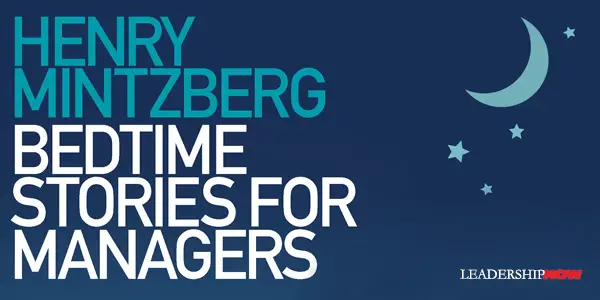 |
 |
02.08.19

Henry Mintzberg’s Bedtime Stories for Managers
MINTZBERG’S 20th book, Bedtime Stories for Managers, is a thought-provoking page-turner. (In that sense I’m not sure it’s good to read just before drifting off.) The stories—a collection or repurposed blog posts—are meant to be pondered. The theme running through most is that managers/leaders need to get out from behind their desks and see the world from the perspective of their employees and customers. To this end, he dedicates the book to “all those managers who eat the scrambled eggs to help their organization work like a cow.” That requires some explanation. Scrambled Eggs The first story tells of an experience he had on the soon to be defunct Eastern Airlines (they went bankrupt in 1991). He was served some awful scrambled eggs. After complaining to the flight attendant, she said, “I know. We keep telling them; they won’t listen.” Management is not eating the eggs. They’re not running the business; they’re reading financial statements. The financial analysts were certainly reading those statements, and probably explaining the airline’s problems in terms of load factors and the like. Don’t believe a number of it. Eastern Airlines went belly up because of those scrambled eggs. And here’s the kicker: Some years later, after telling this story to a group of managers, one of them, from IBM, came up to tell me another story. The CEO of Eastern Airlines came rushing in at the last minute for a flight, he said. First class was full, so they bumped a paying customer to put him where I guess he had become accustomed. Apparently feeling guilty, he reportedly made his way to Economy Class (no mention was made of him having to ask where it was). There he apologized to the customer, introducing himself as the CEO of the airline. The customer replied: “Well, I’m the CEO of IBM.” The lesson is that managers/leaders (both sides of the same coin) need to get out and run their businesses. They need a dose of reality. “Managing is not about sitting where you have become accustomed,” writes Mintzberg. “It’s about eating the scrambled eggs.” Work Like a Cow In section 2 we learn about the cow. It comes as a reaction to a clever and insightful 1995 advertisement from SAP. In the ad, the copy reads: “This is an organizational chart that shows the different parts of a cow. In a real cow the parts are not aware that they are parts. They do not have trouble sharing information. They smoothly and naturally work together, as one unit. As a cow. And you have only one question to answer. Do you want your organization to work like a chart? Or a cow?”
This is a very serious question. Ponder it. Cows have no trouble working like cows. Nor, for that matter, does each of us, physiologically at least. So why do we have so much trouble working together socially? Are we that confused about organizing, for example, all this obsession with charts? Other Lessons A few of the stories take a concept or two out of context to make a point, but the point is well taken. Here are a few lessons gathered from the pages of Bedtime Stories for Managers: Successful managers are flawed—everyone is flawed—but their particular flaws are not fatal under the circumstances. Reasonable human beings find ways to live with one another’s reasonable flaws. The stories serve best as sort of a reality check. Good night. 
Posted by Michael McKinney at 12:51 AM
|
BUILD YOUR KNOWLEDGE
 

How to Do Your Start-Up Right STRAIGHT TALK FOR START-UPS 
Grow Your Leadership Skills NEW AND UPCOMING LEADERSHIP BOOKS 
Leadership Minute BITE-SIZE CONCEPTS YOU CAN CHEW ON 
Classic Leadership Books BOOKS TO READ BEFORE YOU LEAD |